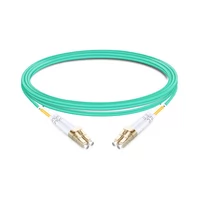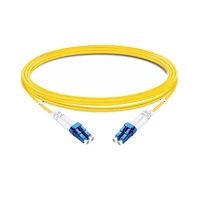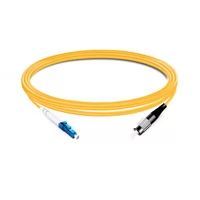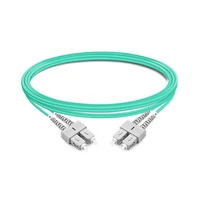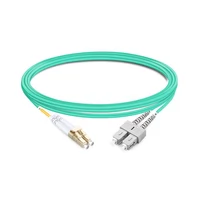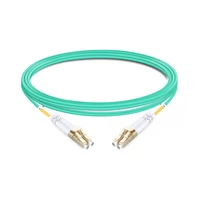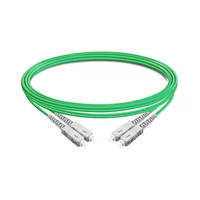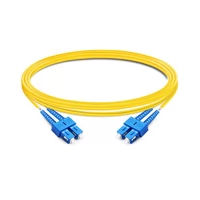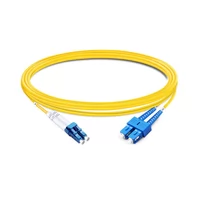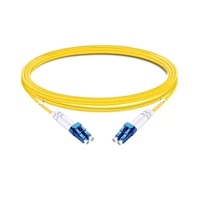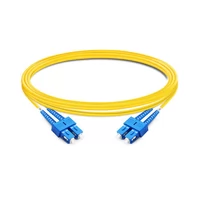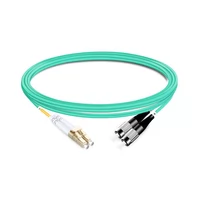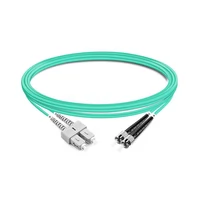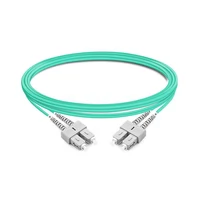Modern telecommunication relies on optical fiber cables, the critical foundation for rapid and dependable data communication. This preface will explain how these cables work by examining their effectiveness in transferring information. Light propagation, complete internal reflection, core, and cladding materials will be discussed as underlying mechanisms forming an overall understanding of optical fiber technology. This article aims to illuminate essential elements, the working principles behind them, and the benefits accrued from their employment within the current data-heavy environment.
Table of Contents
ToggleWhat is an Optical Fiber Cable?

Definition of Optical Fiber Cable
An optic fiber cable is a cable that has one or more optical fibers inside it, which can be used to transmit data as light. These fibers are usually made of plastic or glass and are created to direct light down their lengths using total internal reflection. An optic fiber cable typically includes three parts: the core (where the light goes through), cladding (which reflects all light into the core), and protective coatings. This design enables quick and effective transmission of vast amounts of information over significant distances with minimal signal loss, making it necessary for high-speed modern communication networks.
Composition of Optical Fiber Cable: Glass or Plastic
Based on the properties within them, optical fiber cables are made up of glass or plastic. Glass fibers are mainly used for long-distance communication due to their low attenuation and high bandwidth, which enables data to be transmitted over large distances without losing the signal strength considerably. Conversely, plastic fibers find more application in short hauls because they are more bendable, easier to handle, and cheaper, although they generally have higher losses than glass fibers. The selection between these two types depends on network needs like distance coverage and budgetary constraints, among other performance requirements.
Comparison with Traditional Copper Cables
Regarding performance, efficiency, and long-term cost-effectiveness, optical fiber cables have the upper hand over traditional copper cables. They also guarantee stronger signals over longer distances. One of the main disparities is in bandwidth capacity; fiber optics can transmit much higher data rates than copper wires, which are suitable for high-speed internet and large-scale data transmission. In addition, they have lower attenuation, which enables information to be transmitted without regeneration over more considerable distances, thus making them more effective in carrying data, which reduces the number of repeaters required and, consequently, lowers overall infrastructure cost.
Also, unlike copper cables, which are easily affected by electromagnetic interference (EMI), especially in electrically noisy environments, optical fibers are EMI immune; hence, this guarantees reliable transmission of information with reduced chances of signal deterioration on the way. Conversely speaking, though, it may be true that installation and termination processes for copper wires are generally more straightforward, mainly when dealing with short distance or low bandwidth applications, since they don’t need sophisticated equipment used during handling/splicing of optical fibers, but still, these cannot match their performance levels neither do they meet capacity demands imposed by modern telecommunication/data networks.
How Do Optical Fiber Cables Transmit Data?

Mechanism of Transmitting Data
Light signals are used by optical fiber cables to transmit data. Core, cladding, and protective coating are among the key components of an optical fiber cable. An optical signal starts its journey through a data transmission system as soon as it is generated within the fiber core by a laser or LED. It is required that this signal moves over the core through total reflection, which happens at each bend or twist where light could escape outwards. The function of lower-index sheathings than cores in guided light propagation maintenance cannot be underestimated since they ensure so.
Different modulation techniques are employed on these waves, representing information by changing their intensity, phase, or wavelength. Conversely, electrical signals can be processed and interpreted into electronic devices when photodetectors or optical receivers change them from back-to-light signals. Still, this time as electric currents again, finally becoming light rays once more after having traveled along fiber optics, thus allowing for fast-speed long-distance data transmission, which is needed in today’s telecommunications systems together with computer networks according to their (dis)advantages related with traditional methods.
The Role of Pulses of Light
Optical fiber communication systems require light pulses. Either lasers or LEDs create these light pulses and serve as information carriers that move through the optical fiber. Each pulse stands for a binary state of 1 or 0, so digital data can be sent. To achieve high-speed data transmission rates, one must generate short light pulses with exact timing. The light signals keep their shape along the fiber optic cable due to total internal reflection at the core-cladding interface. This technique ensures the most minor signal loss and allows for the transmission of information over vast distances with small attenuation. Data capacity could be increased even more using advanced modulation methods such as WDM (wavelength division multiplexing), where many different wavelength light pulses can travel simultaneously over one fiber, dramatically increasing bandwidth efficiency.
Concept of Total Internal Reflection
The total internal reflection is a fundamental principle that controls how light is transmitted through optical fibers. It occurs when light in the core of an optical fiber comes in contact with the boundary between the core and cladding at an angle more significant than the material’s critical angle. Therefore, instead of bending outwards from the core, all of it reflects into it. This light can be effectively channeled through a single fiber optic cable for high-speed data transmission. This keeps that effect confined within the core so it can travel long distances without much loss.
The critical angle depends on the refractive indices of materials used to make cores and claddings. In other words, total internal reflection ensures that signals do not lose strength or power as they propagate along these channels over large areas such as cities or even continents. Bandwidths are, therefore, not compromised anywhere along these routes, which is why this technology has become vital to modern communication systems worldwide.
What are the Different Types of Optical Fiber Cables?

Single-Mode Fiber Cables
Single-mode fiber cables are designed to transmit light directly down the fiber with little dispersion for long-distance communication. Typically having a small core diameter of around 9 micrometers, these fibers accept only one path for light propagation. Modal dispersion is significantly reduced when light is confined into such a tight channel, allowing data to travel further distances at wider bandwidths than it would on multimode fibers.
For this reason, single-mode fibers find their greatest use in telecommunication networks, including long-haul communications systems, like metro networks or cable TV systems, where high data integrity over large transmission distances must be ensured. They form an important part of any modern backbone infrastructure because they can cope with high-speed and high-capacity data flows typical of today’s telecommunications environment. Installing single-mode fiber optic cable is more expensive than installing multi-mode fiber optic cable because of the precision required during installation and associated equipment costs such as lasers.
Multi-Mode Fiber Cables
For use in short-distance communication, multi-mode fiber cables are made to pass many light modes or paths at once. These fibers have a larger core diameter, typically around 50 to 62.5 micrometers, which enables the propagation of multiple light modes. Fiber optic cables have been used more extensively in different applications than before. Compared with single-mode fibers, this bigger size of cores contributes to higher modal dispersion, thus limiting the distance over which data can be sent through these fibers without considerable signal deterioration.
Multi-mode fibers are commonly used in local area networks (LANs), data centers, and other enterprise installations where shorter cable runs are typical due to their design features. Regarding hardware and installation costs, multi-mode fibers are generally cheaper than single-mode ones because they employ LEDs as light sources instead of lasers. An inexpensive yet reliable multi-mode fiber optic system could be an excellent option for high-speed data transmission within areas that do not require long-haul transmissions.
In summary, multi-mode fiber cables provide affordable solutions for high-capacity applications over short distances, making them best suited for building and campus environments within their working range.
Comparison of Different Fiber Cable Types
When comparing single-mode and multi-mode fiber cables, the user should consider four main considerations: core diameter, distance capabilities, bandwidth, and cost.
Core Diameter
- Single-Mode Fibers: These fibers have a smaller core diameter of about 9 micrometers. They let only one light mode propagate through them, reducing modal dispersion, which enables long-distance transmission.
- Multi-Mode Fibers: The core diameter is larger than that of single-mode fibers. Typically, they range between 50 and 62.5μm, simultaneously supporting many different light rays or modes. However, they suffer from higher modal dispersion, which limits their adequate transmission distances.
Distance Capabilities
- Single-Mode Fibers: They are suitable for communication over long distances, which can go up to 40 kilometers or more, depending on the quality of fiber and equipment used. For this reason, fiber optic cables have become the standard media for long-haul data transfer.
- Multi-Mode Fibers: These are used in short-haul applications where the distance does not exceed a few kilometers, such as within buildings or between different departments on campus networks. They are also good at maintaining signal strength over short distances.
Bandwidth
- Single-Mode Fibers: They offer higher bandwidths necessary for high-speed data transmission rates required by metropolitan area networks (MANs) and telecommunication links.
- Multi-Mode Fibers: Although their bandwidth is lower than that provided by single-mode fibers, it is still sufficient to support fast speeds over shorter lengths; this makes them suitable for local area networks (LANs) and data centers, etc.
Cost
- Single-Mode Fibers: Such cables are usually expensive due to the precision manufacturing techniques needed during production and the requirement for lasers as light sources.
- Multi-Mode Fibers: On the other hand, these tend to be cheaper for installation costs because they use LEDs, which are generally less costly than lasers.
To sum up, whether single or multimode fiber optic cable is chosen will largely depend on network distance requirements, bandwidth needs, and budgetary constraints. Single-mode fibers are ideal for long-haul, high-capacity systems, while multimode fibers may be more affordable for short-range links with high data rates.
Where are Optical Fiber Cables Used?

Applications in Data Centers
Optical fiber cables are a must-have in today’s information centers, allowing vast amounts of data to be sent quickly and dependably. Their large bandwidths and low latency make them indispensable when linking servers or connecting storage systems with network switches within the boundaries of a data center. They ensure that communication is done without any interruptions. Data centers utilize optical fibers at their core, aggregation, and access layers to cater to different amounts of data traffic handled by various network parts. Furthermore, these cables support fast protocols such as Ethernet, Fiber Channel, or InfiniBand, which enable smooth transfer and sharing of information necessary for cloud computing services like virtualization and processing big volumes of data at once. With the growing need for information storage space, optic fibers also offer the scalability required by future-proofing operations within data centers.
Use in Digital Audio and Video Transmission
Digital audio and video transmission heavily rely on optical fiber cables because they have a fast data transfer speed and immunity against electromagnetic interference. This is why they are most suitable for professional audio-visual applications such as broadcasting, live events, and high-definition video streaming. The utilization of optical fibers ensures that the signal degrades the least, even if it travels long distances, keeping the quality of audio and videos intact. Additionally, they can carry massive amounts of bandwidth, allowing them to transmit uncompressed high-definition audio and video formats necessary for maintaining fidelity within professional environments. As technology evolves, so too does optical fiber’s role in digital multimedia, which continues to grow with the need for higher resolutions and more complex AV experiences.
Optical Fiber in Residential and Commercial Internet
In residential and commercial internet connections, optic fiber technology is very important. These applications require fiber-optic wires more and more because they are effective. It provides incomparable internet speeds much higher than those of traditional copper-based broadband connections, which allows for smooth streaming, online gaming, or large file transfers, among others. Fiber to the Home (FTTH) infrastructure in residential areas ensures high speeds as well as steady Internet access, thereby improving smart home gadgets’ performance while working remotely becomes better too. On a commercial level, optical fibers support strong internet connections with high capacity necessary for business operations, cloud services, or data-intensive applications. This technology’s low latency plus wideband width capacities significantly meet the growing need for dependable, fast personal and professional internet solutions. It also performs well when it comes to fiber optic cables.
What Challenges Do Optical Fiber Cables Face?

Attenuation and Signal Loss
The primary causes of attenuation and signal loss in optical fiber cables are absorption, scattering, and bending losses. Absorption occurs when fiber impurities take in light energy and convert it into heat. Reducing such losses allows data to be transmitted more efficiently through fiber optic cables. Scattering occurs, especially Rayleigh scattering, when light is dispersed in different directions due to small-scale irregularities found within the material making up the fiber itself. Bending losses arise if there is an abrupt bend or kink on the fiber, causing light to leak from its core area. Intrinsic and extrinsic factors contribute to these losses, which affect the efficiency and performance of systems for communication using optical fibers. These problems can be solved by following correct installation procedures, performing regular maintenance activities, and selecting materials with higher quality levels, which will help minimize this issue, hence ensuring maximum signal transmission.
Fiber Optic Cable Installation Challenges
Various challenges must be considered during installation to ensure that fiber optic cables perform at their best for a long time. The first challenge is the environment where they will be installed because sometimes they have to go through hard-to-reach places like underground ducts or buildings with intricate designs. It is necessary to handle them properly so as not to cause any physical damage that might result in attenuation and loss of signal. Furthermore, splicing and connectorization must be very accurate to maintain the integrity of signal transmission. Every single point of splice and connector should be done to minimize loss and reflection; thus, this calls for special training and equipment. Last but not least, it is essential to follow all local governing rules and regulations as well as industry standards during installation so that there are no future operational problems or compromises on safety measures. These difficulties can be overcome by careful planning coupled with execution, thereby achieving reliability and efficiency in fiber optics networks.
Cost of Fiber Optic Deployment
Several factors determine the cost of setting up fiber optic networks. These include the installation site’s intricacy, length, type of cable required, and labor, among others. According to leading sources, a foot of fiber optic cable costs about $1 to $6, with slight deviations depending on its type, i.e., single-mode or multi-mode fiber. More expenses come from using specialized tools for splicing and testing besides obtaining permits and following local regulations. Labor alone can take up significant amounts (50%-60%) of total expenditure since this kind of work requires highly skilled technicians; hence, it is expensive. In cities, average deployment costs per mile range between 20k-30k dollars, but these figures may rise in rough terrains that are too tricky for easy access. Thus, careful planning and budgeting should be done during deployment to effectively manage one’s finances while putting up fiber optic infrastructure systems, according to what was found in most sources.
Reference Sources
Frequently Asked Questions (FAQs)
Q: What is the functioning principle of optic cables when transmitting data?
A: Fiber optic cables use light signals to transfer data across a thin glass or plastic filament about the same diameter as human hair. These beams travel through the fibers at tremendous speeds, allowing information to be transmitted over large distances.
Q: What makes it advantageous to use optic cables rather than traditional copper wire?
A: Optic cables have several advantages over conventional copper wires, including higher bandwidths, faster data transmission rates, and immunity to electromagnetic interference. Additionally, fiber optics can handle more data with less signal loss over longer distances; therefore, they are ideal for efficiently carrying massive amounts of information.
Q: How does the bandwidth of fiber optic cables compare with that of copper wire?
A: Fiber optic cable provides much wider bandwidths than copper wire. This increased capacity enables more significant quantities of data to be transferred significantly faster, essential for modern communication systems and high-speed internet connections.
Q: Why do Fiber Optic Cables have immunity to Electromagnetic Interference (EMI)?
A: Unlike electrical signals in transmitting information through other types of wires, fiber optics employ light signals unaffected by EMI. Therefore, they do not pick up any external electrical noise or interference, guaranteeing cleaner and more reliable data transmission.
Q: What materials are used to make fiber optic cables?
A: Fiber optic cables consist of very narrow threads made from either glass or plastic whose thickness approximates a single human hair. These filaments help in efficient transmission and speediness while surrounding cladding confines light within their core during propagation.
Q: Are long-distance communications made possible by fiber optic cables?
A: Fiber optic cables are used in far-reaching communication systems because they can send data over long distances without losing quality. This is very suitable for applications that quickly move large amounts of data across vast areas.
Q: How does the information go through a fiber optic cable?
A: Information going through a fiber optic cable is transmitted through light signals. These signals are produced at the beginning, bounce off the walls as they travel down the thin strands, and either get turned back into electrical signals or read as light signals for high-speed data applications when they reach the end where they’re received.
Q: What are some common uses of optical fibers?
A: Optical fibers are typically used in internet/telecommunication networks, medical imaging devices, military/aerospace technology, and industrial/commercial networking systems. They have higher bandwidths and transmit data faster than any other data transfer medium, so they can be applied wherever efficient, reliable data transmission is needed. Fiber optics can also carry vast amounts of information at incredible speeds.
Q: How does understanding how fiber optic cables work benefit communications systems?
A: Understanding how fiber-optic cables operate improves communication system design and implementation. Infrastructure planning becomes more straightforward, and knowledge about wider bandwidths and immunity from electromagnetic interference leads to more robust, faster data communication networks, which would not have been possible without this understanding.
Related Products:
-
 3m (10ft) Duplex OM4 Multimode LC UPC to LC UPC PVC (OFNR) Fiber Optic Cable
$3.90
3m (10ft) Duplex OM4 Multimode LC UPC to LC UPC PVC (OFNR) Fiber Optic Cable
$3.90
-
 3m (10ft) Duplex OS2 Single Mode LC UPC to LC UPC OFNP Fiber Optic Cable
$3.10
3m (10ft) Duplex OS2 Single Mode LC UPC to LC UPC OFNP Fiber Optic Cable
$3.10
-
 3m (10ft) Simplex OS2 Single Mode LC UPC to FC UPC PVC (OFNR) Fiber Optic Cable
$1.40
3m (10ft) Simplex OS2 Single Mode LC UPC to FC UPC PVC (OFNR) Fiber Optic Cable
$1.40
-
 1m (3ft) Duplex OM3 Multimode SC UPC to SC UPC OFNP Fiber Optic Cable
$3.00
1m (3ft) Duplex OM3 Multimode SC UPC to SC UPC OFNP Fiber Optic Cable
$3.00
-
 1m (3ft) Duplex OM3 Multimode LC UPC to SC UPC OFNP Fiber Optic Cable
$3.00
1m (3ft) Duplex OM3 Multimode LC UPC to SC UPC OFNP Fiber Optic Cable
$3.00
-
 1m (3ft) Duplex OM3 Multimode LC UPC to LC UPC OFNP Fiber Optic Cable
$3.00
1m (3ft) Duplex OM3 Multimode LC UPC to LC UPC OFNP Fiber Optic Cable
$3.00
-
 1m (3ft) Duplex OM5 Multimode SC UPC to SC UPC LSZH Fiber Optic Cable
$3.40
1m (3ft) Duplex OM5 Multimode SC UPC to SC UPC LSZH Fiber Optic Cable
$3.40
-
 1m (3ft) Duplex OS2 Single Mode SC UPC to SC UPC OFNP Fiber Optic Cable
$2.50
1m (3ft) Duplex OS2 Single Mode SC UPC to SC UPC OFNP Fiber Optic Cable
$2.50
-
 1m (3ft) Duplex OS2 Single Mode LC UPC to SC UPC OFNP Fiber Optic Cable
$2.50
1m (3ft) Duplex OS2 Single Mode LC UPC to SC UPC OFNP Fiber Optic Cable
$2.50
-
 1m (3ft) Duplex OS2 Single Mode LC UPC to LC UPC OFNP Fiber Optic Cable
$2.50
1m (3ft) Duplex OS2 Single Mode LC UPC to LC UPC OFNP Fiber Optic Cable
$2.50
-
 1m (3ft) Duplex OS2 Single Mode SC UPC to SC UPC LSZH Fiber Optic Cable
$2.70
1m (3ft) Duplex OS2 Single Mode SC UPC to SC UPC LSZH Fiber Optic Cable
$2.70
-
 1m (3ft) Duplex OM4 Multimode LC UPC to FC UPC PVC (OFNR) Fiber Optic Cable
$2.90
1m (3ft) Duplex OM4 Multimode LC UPC to FC UPC PVC (OFNR) Fiber Optic Cable
$2.90
-
 1m (3ft) Duplex OM4 Multimode SC UPC to ST UPC PVC (OFNR) Fiber Optic Cable
$3.00
1m (3ft) Duplex OM4 Multimode SC UPC to ST UPC PVC (OFNR) Fiber Optic Cable
$3.00
-
 1m (3ft) Duplex OM4 Multimode SC UPC to SC UPC PVC (OFNR) Fiber Optic Cable
$3.00
1m (3ft) Duplex OM4 Multimode SC UPC to SC UPC PVC (OFNR) Fiber Optic Cable
$3.00

